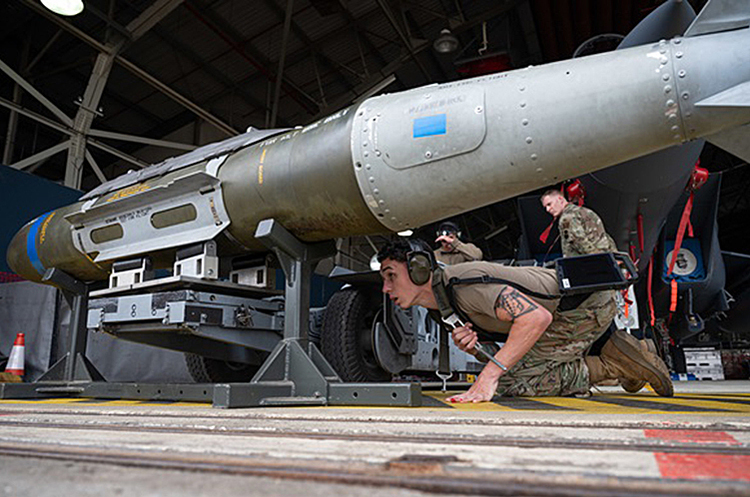GLSDB glide bombs: How Ukraine can take advantage of their unique characteristics
On the capabilities of this weapon and the history of its invention

On February 3, 2023, the Pentagon announced the allocation of another $2.175 billion military aid package to Ukraine. In addition to ammunition (including Javelin anti-tank missile systems), armoured vehicles, and HAWK air defence systems, the United States is transferring for the first time the Ground-Launched Small Diameter Bomb (GLSDB) manufactured by Boeing, which has a target range of 94 miles (150 km). Military expert Mykhailo Zhyrokhov has told Mind what capabilities GLSDBs have and about their invention.
Reuters first reported on Boeing's proposal to launch GLSDB production for Ukraine in November 2022. At that time, one expected that GLSDBs could appear in our country in the spring, which turned out to be quite close to reality.
History of the emergence of such a hybrid weapon
In the early 2000s, the U.S. Army began to decommission M270 MLRS rockets with an M26 cluster warhead. In fact, it was one of the first missiles for this missile system that was used in combat during Operation Desert Storm in 1991.
It was then that its shortcomings were discovered – the relatively short range and the fact that M77 submunitions were practically ineffective against armoured targets. As a result, a new M31 projectile was quickly developed and put into mass production, which became the main projectile for both the M270 and M240 HIMARS.
The M26 was discontinued, but there was no hurry to dispose of it, and there were many of them left in stock. In addition, there were lots of GBU-39 light-guided aircraft bombs (total weight 130 kg) in storage. And that's when Boeing came on the scene and, together with the Saab AB group, offered a kind of hybrid weapon that combined the M26 rocket engine and the GBU-39 bomb in the dimensions of a standard MLRS missile.
GLSDBs have modern types of guidance
It should be noted that various modifications of the GBU-39 (except the basic version, there are also GBU-39/B, GBU-53, GBU-53B and GBU-39A/B) are equipped with an inertial/satellite guidance system, a semi-active laser or an active radar homing head.
The combat capabilities of a bomb depend on the type of guidance system. For example, guidance based on navigation systems allows attacking only stationary targets, while laser and radar homing head systems can also hit moving targets.
At the same time, the modification with a laser head requires target illumination, which can be done either from the ground or from a drone, such as the Bayraktar, which is in service with the Ukrainian Armed Forces, or the Puma, which has been announced in the same February package of American aid. However, such advanced models are unlikely to be transferred to Ukraine, at least at the first stage.
The gliding bomb has waited for its time
The companies used their own money to create a prototype, which was presented in 2006. The principle of operation was quite simple. After launching from a HIMARS or M270 MLRS, the bomb is brought to a certain altitude, separates from the missile, unfolds its mini-wings, and plans to reach its target, which is illuminated by a laser or according to coordinates determined by GPS.
At the time, however, the US military was not interested in this project, at least because the defence budget had enough money to purchase "real" tactical missiles such as the MGM-140 ATACMS with a range of 300 kilometres, and the bombs could also be safely used from aircraft.
GLSDB has been tested three times since 2015. During the tests, the GLSDB flew more than 81 miles (130 km) and hit a target within 40 inches (102 cm) with GPS guidance, according to a Boeing official familiar with the results.
According to Saab's website, the glide bomb can overcome electronic jamming, be used in all weather conditions, and be used against armoured vehicles.
russian air defence will not like the GLSDB
In general, looking at the characteristics, it seems that GLSDB can be a very effective weapon.
Foremost, it is worth noting the very small effective scattering area (only 0.015 square metres), which makes it difficult to counter even modern anti-aircraft missile systems, in particular the Pantsir-S1 systems, which are the main means of short-range air defence of the russian occupation corps in Ukraine.
In addition, the GLSDB launches in the direction of the target on an aero-ballistic trajectory and then splits, which clearly does not give anti-aircraft gunners the confidence to intercept it.
Western military experts say that such munitions will be most effective in case of strikes within the city, with the support of ground troops from the air against airfields, buildings, armoured vehicles, firing points, MLRS and air defence systems.
They will be less effective when used against deep bunkers, structures, large infrastructure facilities and buildings, industrial enterprises, bridges, and enemy manpower.
Ukraine needs weapons "here and now"
Taking American publication Bloomberg as a source, domestic and russian media have begun to disseminate information according to which, allegedly according to an unnamed source, the production of GLSDBs for Ukraine may take some time and the weapons may appear on the battlefield only in 9 months.
Obviously, such a timeframe (9 months, as stated in the media) is completely unacceptable in the current conditions of manoeuvre warfare and calls into question the need for such weapons, as they are needed "here and now."
However, it should be noted that there are enough GBU-39s of the first versions in American warehouses, and M26s have been decommissioned at all. Thus, the issue is to establish the supply of such elements as tailplane actuators from HR Textron and folding wings from MBDA Diamondback.
It allows us to say that the production of GLSDB will be several times cheaper than ATACMS missiles (which we have not been receiving yet) – only a few tens of thousands of dollars.
The AFU will be able to hit russian military facilities in Crimea and beyond
In any case, if the Ukrainian Armed Forces receive new long-range weapons and have a sufficient number of launchers, it will at least increase the range of destruction of enemy targets both in the occupied territory of Ukraine (partially even in Crimea) and in russia and belarus (Bryansk, Belgorod, Kursk, Gomel, Brest).
It is worth noting that the Pentagon specifically mentioned that the United States leaves it up to Kyiv's consideration to use these long-range missiles to strike Crimea.
Interestingly, in theory, the GLSDB could hit, for example, the Jankoy airfield, which is currently the main base of russian army aviation in the south.
Helicopters will have to be redeployed somewhere else, which means they will not be able to operate effectively because of the flight range to the combat zone (~250 km). And the russians have too few attack aircraft and bombers to respond to the requests of ground troops. We should also mention the "land corridor" and the Isthmus of Perekop.
To summarise, the GLSDB is currently the most long-range weapon that our Western allies plan to supply us with since the beginning of the full-scale russian invasion. And most likely, this is just a "warm-up" before the delivery of ATACMS, but let's not get ahead of ourselves.
The OpenMind authors, as a rule, are invited experts and contributors who prepare the material on request of our editors. Yet, their point of view may not coincide with that of the Mind editorial team.
However, the team is responsible for the accuracy and relevance of the opinion expressed, specifically, for fact-checking the statements and initial verification of the author.
Mind also thoroughly selects the topics and columns that can be published in the OpenMind section and processes them in line with the editorial standards.



